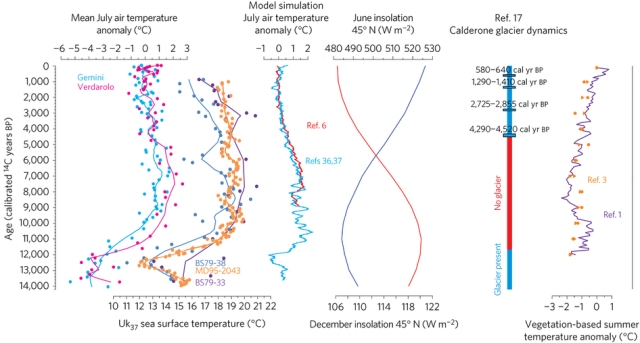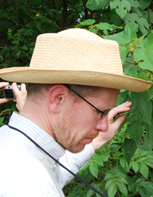Pollen-inferred summer temperature reconstructions from southern Europe show cool early-Holocene summers and warmer late-Holocene summers (Davis et al 2003, Mauri et al 2015). In contrast, warm early-Holocene summers are reconstructed elsewhere in Europe and most of the mid-high latitude Northern Hemisphere, as expected from the increased summer insolation due to orbital forcing.
Since one important use of palaeoclimate reconstructions is to validate climate models by testing whether model simulations of past climate match the climate reconstructed from proxies, it is important to understand whether these cool early-Holocene summer reconstructions are valid. Uncritical use of palaeodata to validate models is not going to be useful.
Time to call in the cavalry chironomids.
Samartin et al 2017 (which we covered in our reading group last week – not all ideas here are my own) reports chironomid-inferred summer temperature reconstructions from two lakes in the Italian mountains. Both (yes there is replication) lakes show a warm early Holocene, consistent with the insolation changes, marine proxy records and climate models, but not the pollen-based reconstructions.

Samartin et al figure 3. Chironomid-inferred mean July air temperature for Lakes Gemini and Verdarolo compared with other palaeotemperature records.
Samartin et al use a combined Swiss-Norwegian chironomid calibration set and report that all the fossil samples have fair/good analogues in this calibration set. I would have liked to have seen a plot of the analogue quality in the supplementary material. Otherwise, I like this paper.
Samartin et al suggest that the pollen-based reconstructions are so different because temperature is not the only control on vegetation in southern Europe. Moisture availability is important, and several millenia of disturbance by humans have replaced the natural vegetation with “humanized vegetation types” such as Garrigue. Thus pollen assemblages from the early Holocene may lack appropriate modern analogues and so pick inappropriate analogues from higher elevations where there are remnant forests. (In June, I am going to a PAGES workshop on improving pollen-based reconstruction. I must remember that in some cases the best reconstruction is no reconstruction.)
There is one problem with Samartin et al. Nature has strict guidelines about the availability of data etc.
A condition of publication in a Nature journal is that authors are required to make materials, data, code, and associated protocols promptly available to readers without undue qualifications.
A data availability statement is to be included in papers which
will report the availability of the ‘minimal data set’ necessary to interpret, replicate and build on the findings reported in the paper.
This is the full data availability statement from Samartin et al:
The chironomid-inferred mean July air temperature records from Gemini and Verdarolo are available at the NOAA National Centers for Environmental Information webpage (https://www.ncdc.noaa.gov/paleo/study/21030). Data from reference 1 (shown in Fig. 3) have been digitized from the original publication. Data from ref. 3 (online resource http://ncdc.noaa.gov/paleo/study/18317), ref. 21 (IGBP PAGES/World Data Center for Paleoclimatology Data Contribution Series no. 2006-106) and ref. 46 (IGBP PAGES/World Data Center for Paleoclimatology Data Contribution Series no. 92-007) have been downloaded from the NOAA National Centers for Environmental Information webpage.
Climate model data from refs 36,37 (shown in Fig. 3) are available at the NCAR climate data webpage (https://www.earthsystemgrid.org/dataset/ucar.cgd.ccsm3.trace.html). Climate model data from ref. 6 can be obtained from H.R. on request.
Notice anything missing?
There is no mention of where the chironomid calibration set and fossil data are archived or how they can be accessed. I do hope this omission was just an oversight.
There is no better explanation of why the data should be made available than this sentence from the statement.
Data from reference 1 (shown in Fig. 3) have been digitized from the original publication.

 @richardjtelford
@richardjtelford